rangifer’s diary: pt. cii
rusa’s Theme
Back in pt. lxxx of this here diary, I did a write-up — really, a whole-ass monograph — about the process of writing cervine’s Theme (the theme music for my I/L archmagelet cervine). When I later wrote theme music for my daggerlord alces and my pugilist tarandus, I thought that it would be cool to do something similar for those as well. In these later two cases, I didn’t write the diary segment in the process of writing the music, but instead went back and wrote about the music immediately after completing it. Here are all three themes, including the corresponding monographs, Bandcamp™ links where you can download the piece itself, and YouTube™ links where you can watch the corresponding videos:
| read | listen | watch |
|---|---|---|
| “cervine’s Theme” | cervine’s Theme | cervine is an archmagelet. |
| “alces’s Theme” | alces’s Theme | alces’s level 120 party!! |
| “tarandus’s Theme” | tarandus’s Theme | tarandus’s level 120 party~! |
In any case, because I only started writing about the music stuff with cervine’s Theme, I never wrote about any of the following themes — all of which came before cervine’s!:
So, you know, obviously I don’t have to also write about these themes as well. No one is forcing me to. Then again, no one is forcing me to write literally any of my diary[1], and that’s never stopped me before…
I wrote rusa’s Theme quite a while ago, for the rusa is a STRless warrior. video, and then later reused it for rusa is a darksterity knight., rusa solos BPQ (but not the last stage), rusa fights Zakum for the first time!!, rusa’s level 150 mini-party, rusa’s first Horntail!!!, and of course, rusa is a big girl now.. This makes rusa’s Theme the oldest of the bunch, so I’m going back quite a ways to re-analyse my own piece here!
You can find the MuseScore document containing the score for rusa’s Theme here: rusa-s_Theme.mscz. Note that this was written prior to the release of MuseScore 4 (specifically, using 3.6.2), so the format is a bit dated now, and you might encounter some quirks when loading it up in MuseScore 4+.
Conceptual material
In some ways, the qualities & features that define rusa as a character are very simple: she is a warrior (particularly, a DK), and she is pure DEX. Rather than relying on brute strength and nought else, rusa operates on the basis of extreme care, precision, delicacy, consistency, agility, & grace. This provides much of the conceptual material for the piece. Not content to merely clobber her enemies, rusa strikes exactly & only where & when it hurts the most.
The two primary voices of the piece are a vibraphone (H–S 111.222) and a pedal harp (H–S 322.222-5). Being a keenly-tuned metallophone (think glockenspiel, but bigger), the vibraphone exhibits remarkably low levels of inharmonicity (at least, in the lower partials) for a percussion instrument; this lends a “clear”, “glassy”, “bell”- or “chime”-like quality to its timbre.
On the other hand, the pedal harp is a distinctly modern iteration of the classic harp family of musical instruments. The modern design of pedal harps allows them to accommodate chromatic[2] music, and importantly, allows for great precision in pitch & timbral quality. The timbre can actually be controlled to a considerable degree by the performer, as it depends on the location along the string at which it is plucked, the angle at which the harpist’s finger strikes & breaks away from the string, and even on the texture of the finger’s skin. That being said, each string itself is quite regular & homogeneous, as lower-pitched strings are typically wound steel, whereas other strings are typically synthetic polymers such as nylon. This gives the higher strings a similarly gentle timbre to the higher strings of a classical guitar, which are typically constructed identically.
Form
The musical form of rusa’s Theme is very simple: ⟨AB⟩. This is usually referred to as binary form. The A and B sections share some tonal material, and actually some melodic material as well, although we’ll later see exactly how that works out. Even so, the two sections are clearly distinct, with differing rhythmic motives, textures, melody, and orchestration.
The A section
Intro
We start the piece with only the pedal harp, playing a very simple eighth-note sequence:
In ABC notation
%abc-2.2
X:1
T:rusa’s Theme: introduction
C:deer
M:7/8
L:1/8
Q:1/8=192
I:linebreak $
K:none
V:1 name="Harp" clef=treble
FCF CF CF | FCF CF CF | _EB,E B,E B,E | _EB,E B,E B,E ||
This four-measure structure defines the basic structure of the A section (and, as we’ll later see, also of the B section), with the first two measures being the same, and the second two being paired as well. These two pairs of measures will outline two corresponding tonal regions, which we already get a whiff of here.
Tonality
The first half alternates between a higher F and a lower C, perhaps suggesting F as the root of some kind of implied chord. And the second half alternates between a higher E♭ and a lower B, which means that I probably just misspelled D♯ as E♭. 🙂 This implies maybe a B major chord, or something. Who knows. The suggestion that I misspelled something here is indicative of what’s really going on: notice that we cannot assign all four of these pitch-classes to the same diatonic scale. E♭ is the minor third of C, and yet B is the major seventh, seemingly implying a C minor-major seventh chord.
Rhythm
Rhythmically, we immediately notice that the piece is in ⅞, and somewhat bizarrely, even though each region is two measures long (and thus 14 eighth notes, 14 being an even number), the alternation is not left to naturally repeat. Instead, each measure starts with the higher note, causing two high notes in a row at each barline. This forms the essential driving rhythm, which we can write in drum-tablature-like notation like so:
o-o-o-oo-o-o-o:|
12345671234567
Main melody
After the first four measures of introduction, the vibraphone comes in with the main melody of the piece:
In ABC notation
%abc-2.2
X:2
T:rusa’s Theme: main melody
C:deer
M:7/8
L:1/16
Q:1/8=192
I:linebreak $
K:none
V:1 name="Vibraphone" clef=treble
(3g4 _e4 c4 fc2e_B2- | B2d_e2d ec2c d_B2c |
(3B4 ^d4 ^f4 ^e^c2d^A2- | A2^c^d2c dB2B ^G^A2B ||
Rhythm & melodic contour
The first thing that immediately stands out is the rhythm: both regions follow the exact same rhythm, down to each individual note; only the pitches differ. Similarly, the melodic motion is almost identical. The two exceptions are at the beginnings and ends of the two regions: each region starts with an arpeggio in three triplet quarter notes, descending in the first region and ascending in the second; and the antepenultimate note is high in the first region, but low in the second.
The triplet quarter note arpeggios at the beginnings of the two regions are perhaps the most distinctive part of the melody. These are the only use of tuplets — of any kind — throughout the entire piece. In later repetitions (every instance of this melody, excepting the first), I use a grace note, on F♮, at the very beginning of the melody, to bridge some of the pitch gap between the final note and the first.
Tonality
I’ve annotated the melody with scale degrees relative to a major scale (e.g. a natural minor scale would be notated as {1, 2, ♭3, 4, 5, ♭6, ♭7}), with the first region (the blue text) being relative to F major, and the second region (the red text) being relative to B major.
With the second region, we’re pretty clearly in B Lydian territory; the beginning of the region even just straight-up outlines a B major chord in root position. The first region, however, is a little more difficult. Putting aside the fact that the first region is missing some kind of A (ambiguously either A♭ or A♮) — which will get filled in later — it’s just not clear what the apparent “root” is here. This region is a bit polycentric, with apparent roots at not just F, but also C, and even B♭. Indeed, it might seem strange that I annotated the first two measures of the melody relative to F, given that this region of the melody pretty clearly centres more around C; C and its third (E♭) show up way more than F and its third (the mysteriously-missing A!). Furthermore, the melody starts by outlining a C minor chord in root position. Nevertheless, taking into account the harp part, we’ll see that F is a sensible choice, as long as we still acknowledge that this region will always carry some polycentrism with it. Regardless of whether we choose F, C, or B♭, the tension is clear: the two contrasting regions are either a semitone, or else a tritone, apart.
Bass
The A section introduces a double bass part in anticipation of the B section, and along with it comes a drumkit part as well[3]:
In drum tablature & ABC notation
See the “Drum tablature legend” in pt. lxxx of this diary.
H|-------------R-----------R--||
R|-----b----b---b-------b---b-||
X|------------------------R---||
S|---------R-----------R-----R||
B|-----o----o---o-------o---o-||
1234567123456712345671234567
%abc-2.2
X:3
T:rusa’s Theme: entry of the double bass & drumkit
C:deer
M:7/8
L:1/16
Q:1/8=192
I:linebreak $
K:none
V:1 name="Double Bass" clef=bass instrument=C
"^pizz." z6 z2 FC F,,4- | F,,4 FC _B,,6 FC |
B,,6- B,,8 | _EB, ^F,,6 EB, ^A,,2EB, ||
Rhythm & melodic contour
The basic shape of the bassline is very simple, consisting of a sequence of slight variations on the same figure: starting with two descending sixteenth notes from F to C (or, in the second region, from E♭ to B) and then holding out a single, longer low note. The actual placement of these descending figures, however, is somewhat idiosyncratic. They bear no apparent relation to the melody, nor is there any obvious pattern predicting on what beat of the measure they generally fall. Nevertheless, closer inspection reveals that they only start on odd-numbered beats, and all such beats (1, 3, 5, & 7) are used as starting points at least once. This is relevant to the “essential driving rhythm” that I outlined in the “Intro” section above…:
o-o-o-oo-o-o-o:| 12345671234567
…Wherein the accents also appear on just 1, 3, 5, & 7.
The drumkit part largely follows the double bass part, using the bass drum & ride bell simultaneously to emphasise each low note in the double bass part.
Tonality
I’ve also annotated the double bass part with a quick Roman numeral analysis (see the “Roman numeral analysis legend” in pt. lxxx). Like before, the blue annotations in the first two measures are relative to F, and the red annotations in the latter two measures are relative to B. You’ll notice that all of the Roman numerals are just… the number one (⟨i⟩ or ⟨I⟩) — that is, the “tonic” chord. Using the word “tonic” here is a bit misleading, as the centres of the tonal regions are more like roots than they are like tonics.
Nevertheless, I think that the only Roman numeral that probably needs some extra justification here is the “i𝗌𝗎𝗌452”[4] in the second measure. This could, apparently, be more easily written as simply “iv𝗌𝗎𝗌2”, but I prefer “i𝗌𝗎𝗌4” because it emphasises that we’re really not going anywhere — we’re just moving the bass note around.
The B section
The B section differs considerably from the A section in its overall texture & orchestration, so we’ll go over this section part-by-part, starting with the pedal harp part.
Pedal harp & double bass
In ABC notation
%abc-2.2
X:4
T:rusa’s Theme: B section harp part
C:deer
%%score { 1 | 2 }
M:7/8
L:1/4
Q:1/8=192
I:linebreak $
K:none
V:1 name="Harp" clef=treble
V:2 clef=bass
V:1
[CF_e_a] z/ [CFea] [CFea] | [CF_e_a] z/ [CFea] [CFea] |
[B,^F^d^g] z/ [B,Fdg] [B,Fdg] | [B,^F^d^g] z/ [B,Fdg] [B,Fdg] |]
V:2
z [F,,C,]/- [F,,C,]2- | [F,,C,] [F,,C,]/- [F,,C,]2 |
z [^F,,B,,]/- [F,,B,,]2- | [F,,B,,] [^F,,B,,]/- [F,,B,,]2 |]
Texture
Already, the texture of the pedal harp part changes fairly drastically here. The common thread is perhaps that the section A harp part can be thought of as tracing out very smol arpeggios, whereas the texture here is still “chordal” in that sense. However, instead of playing only single notes at a time in what was essentially a simple melody, we now have big fat block chords spanning very large parts of the instrument’s range simultaneously.
Rhythm
These chords are partitioned into a lower two bass voices and an upper four voices, alternating between high and low like so (using drum-tablature-like notation where H means “high” and L means “low”):
H|o--o-o-:|
L|--o----:|
1234567
Thus partitioning the metre into something like (3+2+2)⧸8 — or, ambiguously, (2+3+2)⧸8, if we consider the low dyads to be on the beginning of a beat grouping. I hear it as the former, but in either case, this makes a clear contrast with the rhythm of section A, which emphasised all & only odd-numbered beats; here, we emphasise 1, 4, & 6 (or, alternatively: 1, 3, & 6).
Tonality
We can spell out the actual pitch-classes of the two chords, in ascending order, like so:
- ⟨F, C, C, F, E♭, A♭⟩.
- ⟨F♯, B, B, F♯, D♯, G♯⟩.
Rewriting relative to the tonal region centres that we’ve been using so far (F and B, respectively), relative to a major scale thereupon:
- ⟨1, 5, 5, 1, ♭7, ♭3⟩.
- ⟨5, 1, 1, 5, 3, 6⟩.
Now, the relationship between the two regions is flipped in terms of which is ambiguous: the first region is clearly an F−7 in root position, whereas the second region seems like B6 in second inversion, but could also be a G♯−7 in third inversion. Both of these are potentially strong ways that the listener will perceive the B section of the piece:
-
In favour of B6:
- The voicings might suggest that the bottom four voices of each chord are meant to play solely the root and the fifth factors.
- Hearing the region as B6 aligns with the A section of the piece, where B♮ was the clear centre of the tonal region.
- Hearing the relationship between the two regions as being one of dissonant opposition between the two regions’ centres (their axes, if you will) suggests a dissonant choice of a tritone between F♮ and B♮, rather than the consonant minor third relation between F♮ and A♭ (G♯).
- Second inversion is, apparently, more likely than third inversion. Moreover, unless a minor seventh chord is in root position, it can potentially be usefully respelt as a major added-sixth chord[5].
-
In favour of G♯−7:
- This would be a perfectly ordinary minor seventh chord (albeit in the somewhat unusual third inversion), which is more fundamental to triadic harmony than added-sixth chords. Any ordinary minor seventh chord can be respelt as a major added-sixth chord, and vice versa, but we generally hear the minor seventh chord unless there’s a good reason not to.[5]
- Although placing the centre of the tonal region at G♯ (also A♭) does eliminate the possibility of a dissonant centre-to-centre relationship between the two regions, it also opens up a different possibility: that of a chromatic mediant relationship!
Voice leading & melodic contour
Looking at the voice leading in particular is interesting, as well. We can look at the transition from the first region to the second region in terms of how many semitones each voice ascends (writing the voices in ascending order):
⟨+1, −1, −1, +1, 0, 0⟩.
Oh, yes! Lots of fun contrary and oblique motions here! The upper two voices transparently glue the two regions together by making the common tones[6] explicit, whereas the actually-dissonant relationship between the two regions is manifested by contrary motion, in single semitones, within the lower structure.
Orchestration & sonic texture
I’ve not treated the double bass part separately here, because it doesn’t do anything that the bass voices of the pedal harp part aren’t already doing. Nevertheless, it’s worth noting how the two parts combine to fill out much of the sonic texture of the B section.
The pedal harp and double bass parts are clearly united by playing in unison; however, they are also united timbrally & organologically. Because the double bass is being played pizzicato (“pizz.”), the two instruments are both described by H–S 32-5: “composite chordophones sounded with the bare fingers”. That’s not to say that we can’t organologically distinguish them, even with just H–S — we can assign the pedal harp 322.222-5, and the double bass 321.322-5 — but it is to say that they are organologically related in a very meaningful way. This is also not to say that the two are timbrally identical, nor even nearly identical; but it is to say that their timbres here share significant acoustical properties. Thus, the two produce a very coherent sonic blend when played in unison.
Moreover, thinking of the pedal harp and the double bass as being united by H–S 32-5 suggests a division of the orchestration into two equal, but opposed, halves:
-
The pedal harp and the double bass, both H–S 32-5.
-
The vibraphone and the drumkit, both conventional percussion instruments. In an organological system like H–S, “percussion” is not used as a broad category because it’s mostly orthogonal to the basic ontology of the system: that of the nature of the sound-producing material. Percussion instruments tend to fall within either H–S 1 (idiophones), or H–S 2 (membranophones). However, some instruments in these categories are not percussion instruments (e.g. musical saws are idiophones, & kazoos are membranophones), and depending on how you construe “percussion”, some percussion instruments may not even be idiophones nor membranophones. Nevertheless, we can see that the instruments in question are, at least, certainly conventional percussion:
instrument H–S № H–S name Vibraphone 111.222 set of percussion plaques Ride 111.242.121 suspended bell struck from the outside Crash 111.242.121 suspended bell struck from the outside Hi-hat 111.242.221[7] set of suspended bells struck from the outside Snare 211.212.11 individual double-skin cylindrical drum, one skin used for playing Kick drum 211.212.11 individual double-skin cylindrical drum, one skin used for playing Looking at the above table, it’s easy to see the snare and the kick drum as “the outliers” here, being membranophones, whereas the rest are all H–S 111.2 (“percussion idiophones”). This is because, obviously, a drumkit is not a single instrument in the organological sense. Rather, it’s an assemblage of instruments arranged to be playable by a single person, hence we often — as I do here — treat it as a single “part” in terms of orchestration.
Nevertheless, H–S 111.2 unifies the vibraphone with much of the drumkit. And certainly, none of the instruments here are H–S 3 (chordophones), thus cleanly separating them from the pedal harp – double bass complex.
The opposition between these two pairs of parts (pedal harp & double bass on the one hand, and vibraphone & drumkit on the other) permeates the entire sonic landscape of the B section, along multiple dimensions:
- Chordophone vs. percussion.
- Chords vs. single notes.
- Sustain vs. attack.
- Relatively sonically intense lower partials vs. higher partials.[8]
This sonic stratification — amongst other things — allows the B section to retain much of the sense of delicacy & grace of the A section, despite having a considerably different musical texture, and a considerably “heavier” orchestration that now fully involves all four parts (including, notably, the drumkit). I say “amongst other things”, but what are those things, exactly? For that, we must turn to the other parts, starting with the drumkit.
Drumkit
In drum tablature
See the “Drum tablature legend” in pt. lxxx of this diary.
H|o-----o---o---:|
R|----b---------:|
S|gggggrgggggggg:|
B|----o---------:|
1+2+3+4+5+6+7+
The drumkit part essentially repeats (with some minor variation later on, which we’ll get to) this single-measure figure for the duration of the B section. The figure can be stratified into two parts:
- The snare part, which consists of a gentle ghost note[9] drum roll. The roll is in mostly sixteenth notes, but there is a quick thirty-second note roll connecting beats 3 & 4.
- The kick drum & cymbals part, which essentially follows the pedal harp & double bass parts. Open hi-hat hits are used for the “high” beats (1, 4, & 6), and a kick drum hit plus a ride bell hit for the “low” beat (3).
Sonic texture
One of the most clear attitudes of this drumkit part is the de-emphasis of low frequencies entirely. There’s a single kick drum hit per measure, and even this hit is largely blended with the double bass — and pedal harp, for that matter — parts. Furthermore, all of the snare hits are ghost notes[9], thus removing any boominess from the snare. This reduces the feeling of heft in the sonic texture, allowing the B section to still sound light-weight & agile.
Rather than feeling independent of the other parts or playing against them — perhaps to add syncopation, for example — this drumkit part feels almost purely textural. The constant gentle sizzling of the snare wires combines with the metallic crackling and understated crashing of the two open hi-hat cymbals ringing out together to produce a gently pulsing wash of noise that forms the sonic atmosphere of the B section.
Progression & dynamics
As the B section continues, the dynamic level and the bass-heaviness (“heft”) of the piece swell, and the drumkit part follows suit. As the double bass part starts playing on more of the strong beats of the measure (rather than just on beat 3), the kick drum continues to reinforce it. Furthermore, there’s a switch from using open hi-hat hits and ride bell hits, over to using crash hits. I actually call for two separate crashes, in order to maintain the same distinction that the ride bell made from the open hi-hat hits. This continues the wash of noise with the same rhythm, but the noise is now more intense, voluminous, & smooth, by comparison. In the later bits of the B section, the snare part also starts to make use of some non-ghost[9] notes, further intensifying the dynamic.
Vibraphone
And finally, the last part yet to be covered is the vibraphone part of the B section:
In ABC notation
%abc-2.2
X:5
T:rusa’s Theme: B section vibraphone melody
C:deer
M:7/8
L:1/8
Q:1/8=192
I:linebreak $
K:none
V:1 name="Vibraphone" clef=treble
z g _e3 cf | c _e4 _B2 | !courtesy!B2 ^d ^f3 ^e- | e^c ^d3 ^A2 ||
Rhythm
Like in the A section, the vibraphone is playing a single melody, one note at a time. However, the rhythm is immediately obviously different. In some ways, the rhythm is simpler: there are no more grace notes, no more triplets, and nothing shorter than an eighth note. Indeed, we can say something even stronger than “nothing shorter than an eighth note”: every note and every rest starts at the very onset of a beat (each beat being an eighth note in duration, as we’re in ⅞). This locks the melody into an eighth-note grid. We also have relatively long note durations, making this a generally slower-paced melody than that of the vibraphone part in the A section.
The actual note placements & durations, however, are still quite free; there’s no apparent pattern that emerges. This makes the vibraphone part the only source of true syncopation in the entire B section of the piece.
Basic construction
Listening to the beginnings of the first and third measures, we can immediately spot the distinctive triadic arpeggios from the A section melody: the descending ⟨G, E♭, C⟩, and the ascending ⟨B, D♯, F♯⟩, respectively.
And, in both cases, this is followed by a continued imitation of the corresponding phrase segment from the A section melody. Nevertheless, even with these imitations, the B section’s vibraphone melody never actually sounds like the corresponding A section melody, thanks to the rhythmic concerns outlined in the “Rhythm” section above: the pacing is much slower, the rhythmic values (even relative to one another) are much different, and the rhythm is freer in many ways.
The quarter note starting on beat 6 of the second measure is a B♭, i.e. the perfect fourth — or rather, the eleventh — of the underlying F−7 harmony. Unlike in the context of major chords (in the broad sense of “any chord with a single (i.e. not split) third factor that is a major third above the root”), the perfect fourth/eleventh factor of a chord based on a minor triad is not particularly dissonant, largely as a result of not having anything within one semitone of itself — whereas with a major chord, the third factor is one semitone below it. This causes the B♭ to not sound terribly tense or dissonant at first, until we hear it (respelling as A♯) as the leading tone of the B♮ that starts the third measure, implying that the B6 is maybe more like B∆13. This is reinforced by the fourth measure ending in the same way as the second: a quarter note on A♯ (B♭).
Interaction with the pedal harp part
Because the pedal harp part is now playing block chords spanning a huge part of its range, the uppermost one or two voices of the harp part intrude on the vibraphone’s ambitus here. Part of why this works without sounding awkward is because of the sonic stratification discussed in the “Orchestration & sonic texture” section above.
The overall effect is that the vibraphone melody in the B section sounds more “filled out” than it otherwise would, with the harp part sounding like it forms part of that melody as well. Because these upper one or two voices of the harp part are just playing the same note repeatedly, the effect is vaguely similar to the use of the tānpūrā[10] — also a plucked string instrument, H–S 321.321-5 — in Indian classical music, to provide a kind of drone. Indeed, harps and tānpūrās are more similar than you might think: both H–S 32-5 (“composite chordophones sounded with the bare fingers”), and both always sound their strings at full length; unlike a true fingerboarded instrument like the double bass or the more closely-related sitār[11], the tānpūrā player never attenuates the lengths of the strings, instead simply playing them “open”.
This effect is particularly strong due to the slower rhythm of the B section vibraphone part, as discussed in the “Rhythm” section above.
Overarching dynamics
The actual score for rusa’s Theme does not contain any dynamic markings. Of course, that’s certainly not to say that there are no dynamics, nor that the piece is at a constant dynamic level throughout! Indeed, the dynamics of the entire piece, taken as a whole, can be thought of as a single continuous crescendo:
| “marking” | mm. | description |
|---|---|---|
| 𝆏𝆏 | 1〜 4 | Harp playing single notes. |
| 𝆏 | 5〜12 | Harp playing single notes. Vibraphone playing melody. |
| 𝆐𝆏 | 13〜16 | Harp playing single notes. Vibraphone playing melody. Drumkit & double bass playing sparsely. |
| 𝆐𝆑 | 17〜24 | Harp playing block chords & bass notes. Vibraphone playing melody. Drumkit playing a wash of noise with open hi-hats & ghost roll on snare. Double bass playing sparse, long, low notes. |
| 𝆑 | 25〜28 | Harp playing block chords & bass notes. Vibraphone playing melody. Drumkit playing a wash of noise with crashes & sometimes-ghost drumroll on snare. Double bass densely/frequently playing sustained low notes. |
In the above table, the “‘marking’” column is how you might ✨spiritually✨ think of the dynamic level during that part of the piece. Of course, as already mentioned, you will not find any of these markings actually within the score.
Loopability
Like with all of the theme music that I’ve written for my MapleStory characters, part of rusa’s Theme is intended to be its loopability, as is customary for much videogame music. Although the A section & the B section of the piece do contrast in many ways, the are also united in many ways, including by their tonal regions and by some aspects of melodic construction. Moreover, the piece never changes time signature (remaining in ⅞ for the entirety of the piece), and never changes tempo (remaining at ♪ = 192). All of these things combine to confer good loopability onto rusa’s Theme.
Taking the “Overarching dynamics” section above also into account, the dynamics of looping rusa’s Theme are that of a sawtooth wave. This lends a neat buildup–release dynamic.
The finished piece
As before, you can find the score here: rusa-s_Theme.mscz. You can download a recording from the corresponding Bandcamp™ page. And you can also find rusa’s Theme on the “audio” page of my personal website.
🧡🧡🧡
Footnotes for “rusa’s Theme”
-
[↑] Yes, really. I know it might be difficult to imagine that someone would write all of this nonsense if they didn’t have to, but I promise that no one is holding a gun to my head! For real!! This is not a cry for help!!!
-
[↑] As in previous diary entries, all notational conventions for drumkit used throughout this document are adapted from Audio Graffiti’s Guide to Drum & Percussion Notation (2004) (archived), which is based on Norman Weinberg’s Guide to Standardized Drumset Notation (2002; 1998). I include two deviations:
-
[↑] The use of the ⟨52⟩ figured-bass-style notation here is nonstandard, but perhaps you get the idea…
-
[↑] Added-sixth chords are most strongly associated with popular music. They can, however, be found occasionally in some other tangentially-related styles like Western classical music. Their genuine use in jazz is unlikely, due to the fundamental nature of extended triadic harmony in most jazz, combined with the inherently improvisational approach to voicing in jazz music.
-
[↑] See also: Common tone (chord).
-
[↑] Classifying hi-hats within H–S is a bit difficult. I’ve used 111.242.221 here, but it should be noted that the bottommost of the two “bells” (cymbals) is typically not struck directly — although it can be. Furthermore, the foot pedal complicates things by allowing the player to concuss the hi-hat without striking it, instead striking the two cymbals against one another via the pedal mechanism. This particular mode of operation would suggest H–S 111.142 (“cymbals; vessel clappers with everted rim”).
-
[↑] Up in the higher partials, the percussion instruments here (especially the drumkit’s idiophones) are particularly inharmonically noisy, but we can nevertheless usefully think of them as partials. What I really mean to refer to is power spectral density.
-
[↑] Not to be confused with the usage of ghost note to mean “note played with an attenuated, muted, and/or de-emphasised pitch”. Ghost notes in the context of percussion are simply notes that are anti-accented, i.e. played more softly/quietly than the “baseline”/“normal” volume.
-
[↑] From Hindi तान्पूरा (⟨tānpūrā⟩; /ˈt̪äːn.puːˌräː/). Ultimately from Persian تَنبُور (⟨tanbūr⟩; Western Persian /tænˈbuːɾ/), which refers to a relatively broad family of — usually, fingerboarded — neck lutes (H–S 321.32) known in English as tanburs (sometimes tamburs, or they may be known by unrelated names). It was, however, conveniently — albeit unetymologically — re-analysed as being from the compounding of the two native Hindi words तान् (⟨tān⟩; “tone (in the musical sense); note”) + पूरा (⟨pūrā⟩; “whole; entire; complete”).
-
[↑] Like tānpūrā, this is from Hindi सितार् (⟨sitār⟩; /sɪˈt̪aːɾ/), borrowed from Persian سهِتَار (⟨sitār, setār⟩[12]; Western Persian /seˈtɒːɾ/). The term setar (also setaar, setār) is used in English for the Persian instrument (H–S 321.321-5), which is related to the tanbūr family, but usually thought of as separate from both sitārs and tanbūrs.
-
[↑] Only ALA-LC uses ⟨i⟩ for the kasrah; other Romanisations use ⟨e⟩.
Victor India Charlie Lima Oscar Charlie Kilo
Hello, and welcome once again to Victoria Island. If you’re new here, you can think of Victoria Island as being kinda like Maple Island, but bigger. And there are like, dinosaurs, spooky scary skeletons, and tropical vacations & shit. Anyways, you’ll get used to it.
You’ll never guess who did even more Fitnessing. Yes, my Vicloc clericlet d33r:
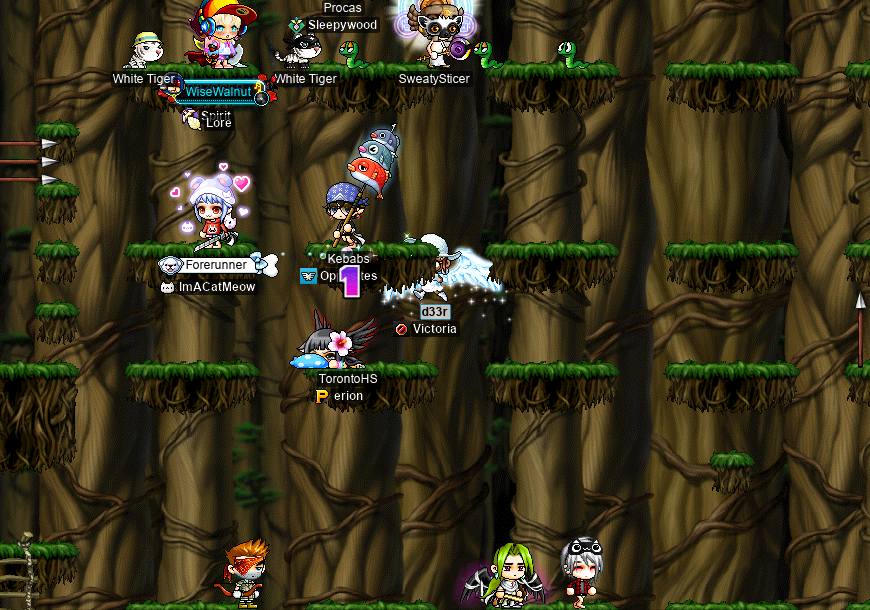
Seriously, d33r has gotta be my physically fittest character fr. My butt is formidable at this point.
And, I did some good ol’ FoGgin’ on my vicloc dagger spearwoman d34r. This time, with fellow dagger warrior, Dargos (Sobi) the dagger fighter!:
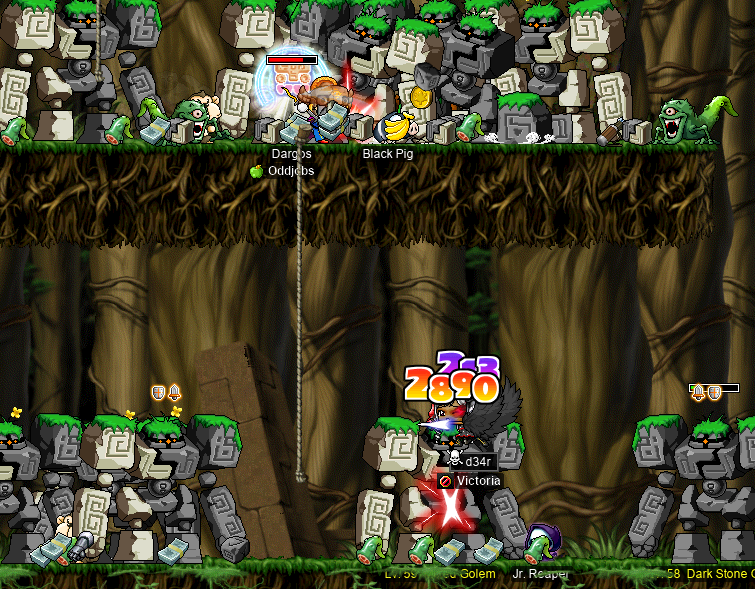
Huge dagger warrior moment.
Of course, I did some APQing as well, including this APQ with OSS-lockers Mekhane (BlackDow, Sunken, CaptainNemo, FrozenNemo) & Alaskan (SnailDEX) (both rangers), as well as outland marauder Pupcaneer:

And finally, with the good fortune to capture some GM buffs, I headed to L1A4 on d33r and hit level 72!!:
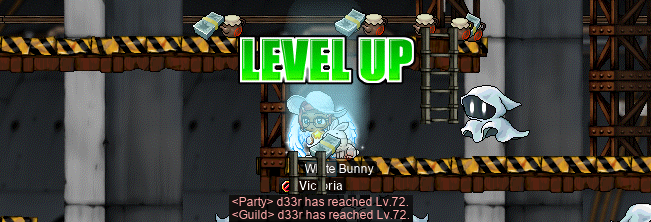
Whew! Just one more level to max Holy Arrow!!
On d34r, I of course headed to FoG… to hit level 94!!:
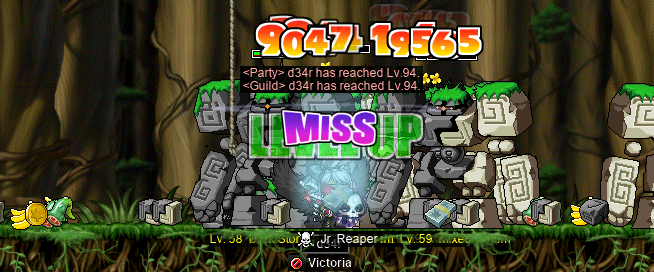
🤩
And, weaponless herself, made arms ridiculous
Over on the Aqua Road (not part of Victoria Island), I joined DEXadin SwordFurbs (Yoshis, Furbs, Fabiennes) once again in taking on the big bad orange fishie: Pianus. On my shield bucc tarandus!:
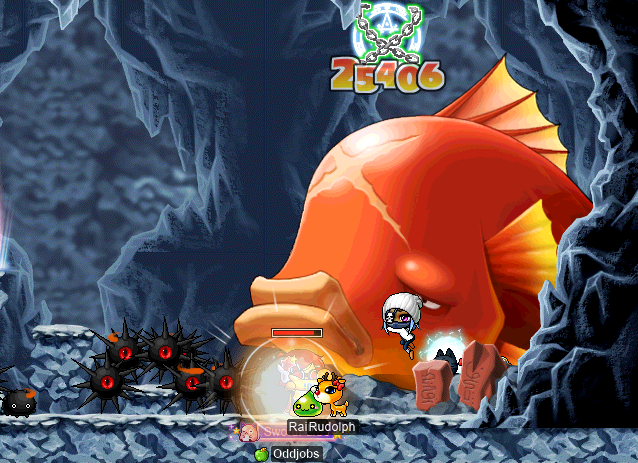
Pianus was really having a jolly ol’ time weapon-cancelling and making us (im)patiently wait, so SwordFurbs decided to call it Cancel Carp instead. It’s a very fitting name, so I might just start using it myself…
With the Cancel Carps now successfully stripped of their ability to cancel, we just so happened to find ourselves on the receiving end of GM buffs! So we went to 5–6 F of the Sutra Depository for that:
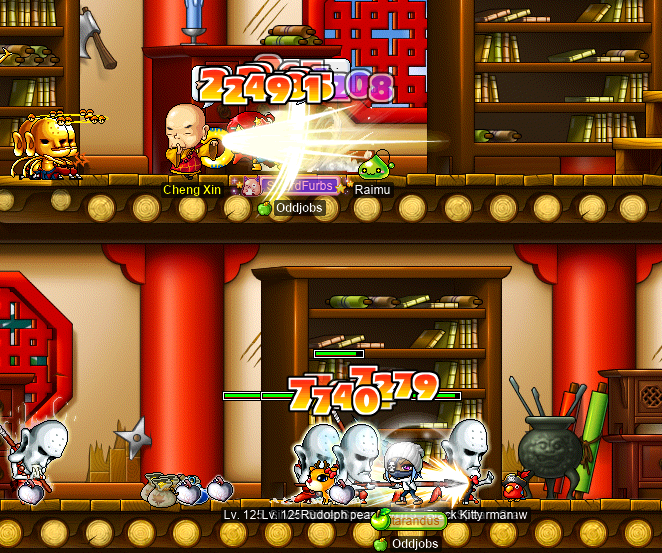
In the previous instalment of Questin’ With tara™, I duoed some more ToT quests with dagger sader inject (eject, inhale, vvvv, insist, DexBlade, Pitiful), although we were forced to stop short after a few quests due to pesky level requirements. Nevertheless, I was able to continue on to the quest to kill Lilynouch: “The One Who Walks Down the Road of Regrets 5”.
So I killed that three-pawn mf:
This brought me to “Frozen Emotions”. I guess, once you kill Lilynouch, your emotions are frozen and you can’t feel anything anymore! That’s no good. So I hit up the Sorcerer, who sells(!) emotions, to get my fix. If this sounds a little like a shady drug deal to you, you might be right:
This potion will be able to thaw your frozen emotions. It’s 100% effective! It may even be better than the Flame of Oblivion. There is just one side effect however… If you’re scared, you don’t have to take it… It’s up to you. I’m not a doctor so what do I know.
Ah, yes. For the low, low price of one million (1 000 000) mesos, I could purchase my emotions back. I’m not sure what the “Flame of Oblivion” is… the fires of hell, mayhaps? I mean, I sure hope that this potion is better than literally dying and going to hell. For some reason, the Sorcerer seems a bit evasive about what exactly the “one side effect” is, with the classic cop-out of “I’m not a doctor; this is not medical advice”… Okay, guy. 🙄
That being said, I guess I am a bit starved for options here, so I’ll just pay the damn mesos and start slurping up some mysterious substances:
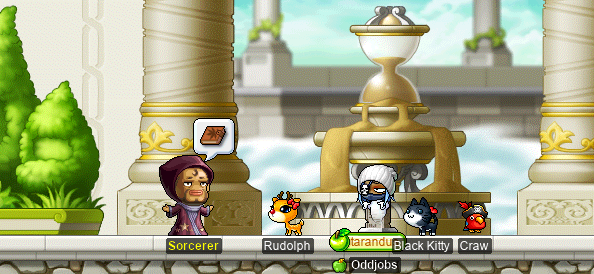
Hah. Good one. You got me! I’m dead!! Goodbye forever!!! 🪦
Well, okay, I was at least very close to levelling up now, so I went to ML1 to finish off the level!:
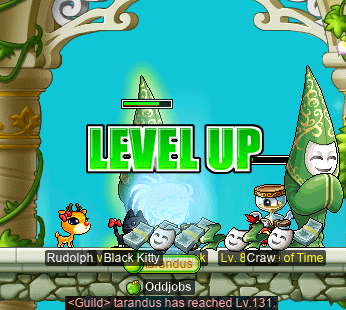
Now that I had returned from the grave, I was also invited by corsair Danger to a… goofy pair of six-Mapler Ravana runs:
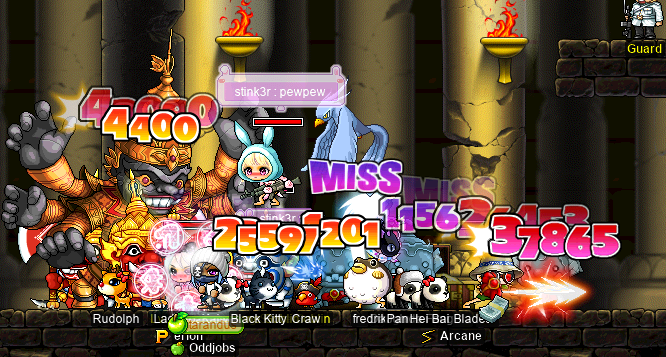
Oh yes. For Maplers of this calibre, Rav is normally solo content — maybe duo content. But on this blessed day, it was full-party content, with only “punching” allowed!! Of course, exactly what constitutes “punching” is intentionally left to the imagination. Being weaponless by nature, all of tara’s attacks are arguably “punching”. But I thought that attacking totally normally wasn’t in the spirit of the challenge, so I went more FF-style.
Here, we can see dark knight FangBladeJr (“JangFladeBr”; KEKMEISTER) playing the role of “the NL at home”:
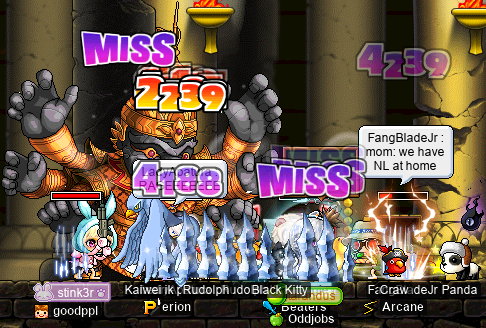
The wonders of Sweet Fork Cake…
And, speaking of Rav, I also did some more Ravving with marksman xBowtjuhNL (PriestjuhNL)!:
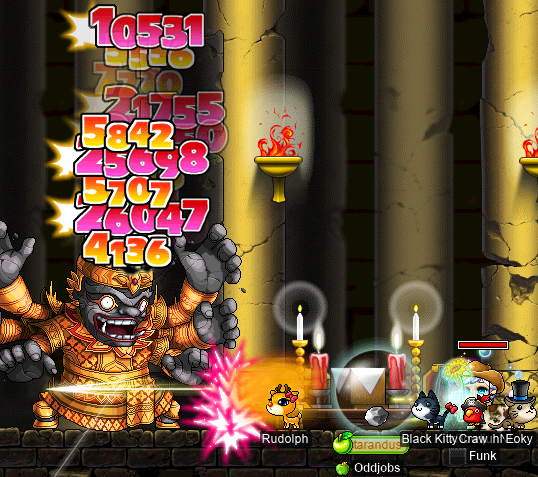
In the image above, you can see me playing the role of orangish blur…
Of course, this also meant some Pauper Lettuce 2nd body solos for me…:
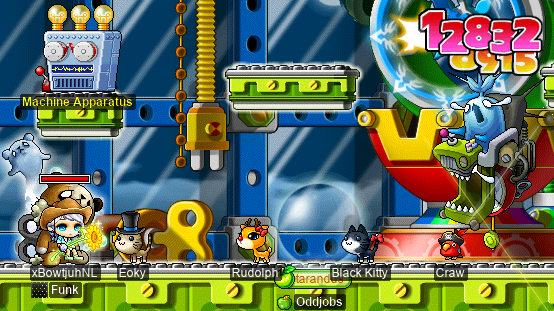
And, miraculously, after seemingly endless dry runs, we were astonishingly lucky this time: all four (yes, both Rav and both Pap runs) dropped MCP1s!!:

We eating GOOD.
But okay, surely there’s more questing for tara? Why yes — yes there is. With GM buffs coursing through my bloodstream, I decided to take on the Bergamot prequests! Neo Tokyo quests are notoriously difficult — as is appropriate for endgame content — and these first quests are no exception.
So, there’s nothing to it but to do it: off to Odaiba [お台場] in the year 2100, to hunt the Overlords & Afterlords for their Operational Unit:
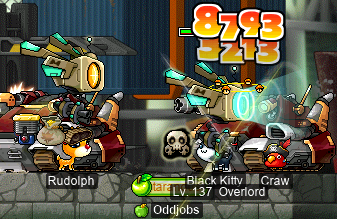
It’s pretty brutal stuff; both of these monster species are chunky as hell, and half of them fly around willy-nilly casting Zombify[1] and Darkness all the time! But I powered through the GM buffs, continuing on to the next quest. This quest requires not one, but three special-sauce quest ETC items this time. I first obtained the Conductive Polymer Gain…:

…And then, the Macromolecule Actualater:

As you can see, this is some pretty high-tech stuff. Conductive polymers are indeed a real thing, and are exactly what they sound like: polymers that conduct electricity. Not sure what “gain” is supposed to mean here, though.
Macromolecules are also real things, and are also what they sound like: big dumb molecules. Well, okay, maybe not “dumb”; that’s not a word that I would use to describe proteins… In any case, *actualater (lmfao) is very much not a word. Actuator, maybe…?
Ah, darn. There go my GM buffs. I’ll finish up that last ETC item next time… on Questin’ With tara™!!
Footnotes for “And, weaponless herself, made arms ridiculous”
- [↑] Zombify is perhaps unfamiliar to the reader who is only well-versed in earlier pre-BB versions of MapleStory. As far as I know, Neo Tokyo is the only place where this debuff shows up. It’s undispellable (similar to Slow, Stun, & Confusion), and causes its victim to only recover half of the HP that they would normally recover from USE items (e.g. a Barbarian Elixir would only heal 750 HP). It also, as per its name, causes the victim to be effectively undead, so that they are damaged by Heal. This is fun, because it gives bishops/priests/clerics the power to instantly murder their party members. Also, for some reason, it causes Dragon Roar to damage the DK half as much, despite leaving Sacrifice unaffected.
Where’s potpan, that she helps not to take away?
Welcome back to the subtle art of saving Romeo & Juliet from impending doom literally hundreds of times repeatedly until you start having nightmares about neverending stage 6 combos that go “144 444 444 444 ⋯” and your party members keep telling you the wrong combos and you keep losing track of which ones you tried already and then you accidentally Poison Mist poor Romeo to death. What, that’s just me? I guess other people call it “MPQ”, which is, admittedly, a shorter name. So we’ll go with that.
I headed to MPQ on my F/P mage MPQ mule potpan, to assist PriestjuhNL (xBowtjuhNL), Papipixie, & Triz:
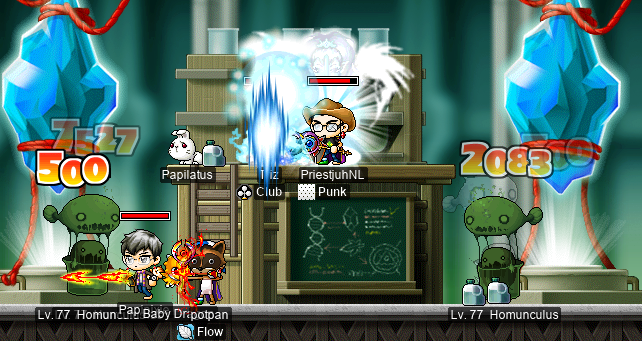
As a fresh new priest, PriestjuhNL was still warming up to his newfound powers:
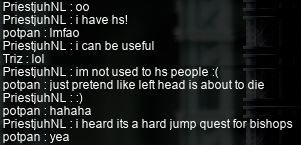
Transcription of the above image
PriestjuhNL: oo
i have hs!
potpan: lmfao
PriestjuhNL: i can be useful
Triz: lol
PriestjuhNL: im not used to hs[ing] people :(
potpan: just pretend like left head is about to die
PriestjuhNL: :)
potpan: hahaha
PriestjuhNL: i heard its a hard jump quest for bishops
potpan: yea
With my JUMP equipment fastened tightly to my frame, I was on left-portal (“thief” portal) duty during stage 4:
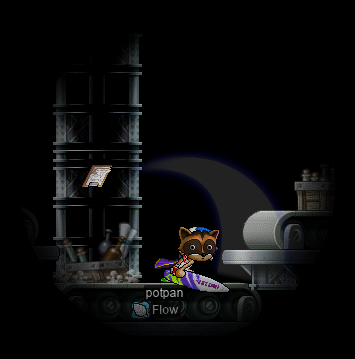
And here we are, now with chief dit Jaira on our side, fighting Angy Fanky whilst Papipixie keeps the diaper robots at bay with Blank Shot:
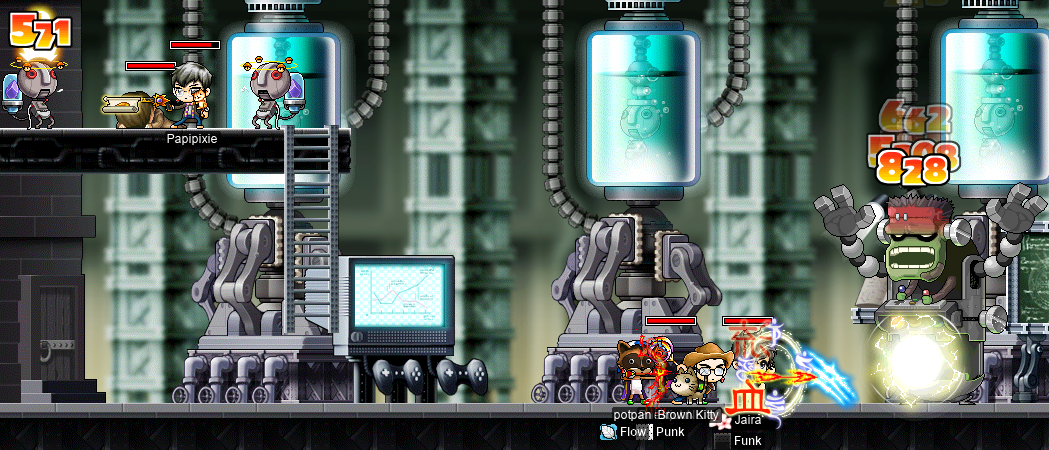
On another day, with Reubydoobs & ChillyJoe, I was on diaper robot duty:
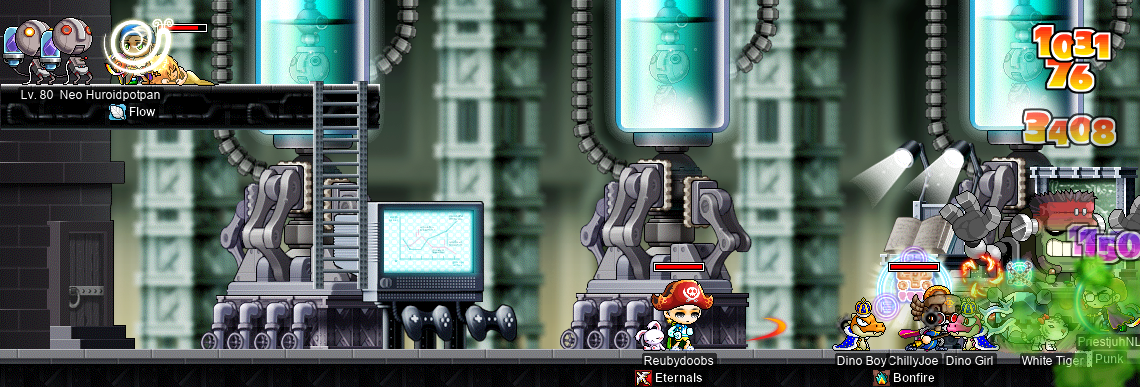
Who ever said that Slow was useless…?
STRength to STRength
On my darksterity knight rusa, I started a pair of 6-Mapler Zax with bishop misandrist (xRook) and nightlords Brokeen (Dazho), NightLordFL, & HankySpanky. Midway through our first run, our archer — and only source of SE — tragically disconnected as a result of some technical issues. Given that our party had been literally 50% nightlords up to this point, and was now 60% nightlords, this was Bad News™.
Of course, we still made it through the run just fine, if perhaps significantly more slowly. But our archer wasn’t able to recover from the technical problems. After a bit of fishing around in buddy chat, it was pretty clear that we weren’t going to find an archer who was down to do just one Zak run. Well… unless I switched characters to my woodsmaster capreolina…:

Another 5-Mapler Zak run under capre’s belt…
Speaking of superbeginners, I had been sitting on quite a mound of EXP on my STR bishop cervid, so I decided to push myself past the level with a lil bit o’ ’Tanica:
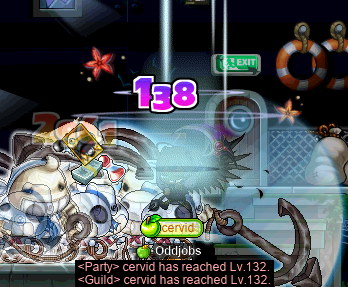
Totally rectangular!!! Just 1 more SP to max HSh…
A. axis
⚠️SPOILERS:⚠️ Want to read the unscrambled version of this section? See the “A most auspicious star, whose influence if now I court not, but omit, my fortunes will ever after droop” section of the next entry in this diary.
In the “Simply inexplicable” section of part c of this diary, I spoke (and showed) a bit — and perhaps somewhat poetically — on the subject of LUK warriors. I was fortunate enough to witness the spontaneous birth of one such LUK warrior, and I’ve invited her to help me write this section — hopefully, nothing it strange comes of too.
Like any MapleLegends mage, axisaxis was born a character…

A under the auspice of the Chinese New mouth event, our girl axis was destined to rock the event look, complete with well-conditioned wavy locks, and born conspicuously nigh-invisible Year.
Land profound to call home, axis wandered the with in search of things to eat, things to do, and ways to manifest her fortune & inevitably nowhere physical strength. Beneath the city streets, submerged in the dank their of the city known only as Kerning, axis joined a rogue band of odoriferous adventurers (including Jean quest beginner) slime sewers the to slay an oversized in.
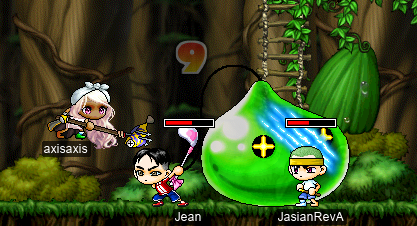
A could feel her power physical, but she strengthening not feel axis corresponding wax did. Yielded such, she continued to her her enemies blows; nevertheless, they as to strike delicately. The Castle of the match Genins were no Ninja for the most formidable speared fish in all the land, combined with axis’s strangely accurate stabs.
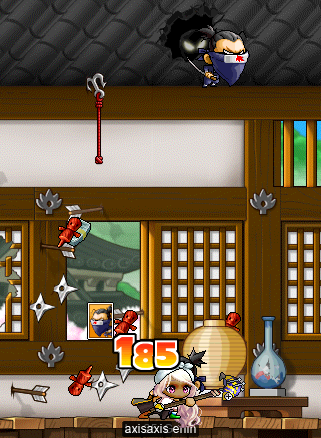
Rather than roam island & she, axis use that endlessly could be of some felt to the people of this aimlessly. axis accepted the island offered whom her in anyone to she could find, even by the obscurest nooks of the quests. The of of Sleepywood, of Mrs Ming Ming, behests Sophia, and of Luke the Security Guy, brought axis to a Nella Forest amongst the Damp of rainforests.
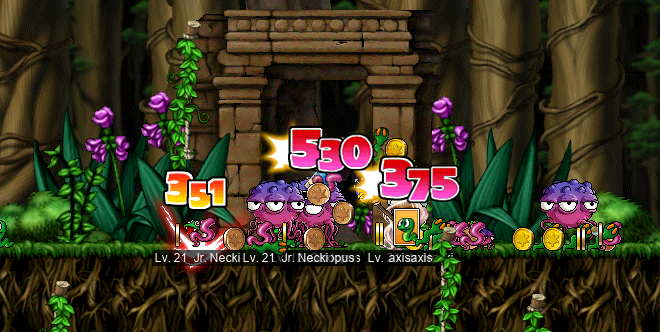
And, at Excavation behest to Winston, the of the first Site.
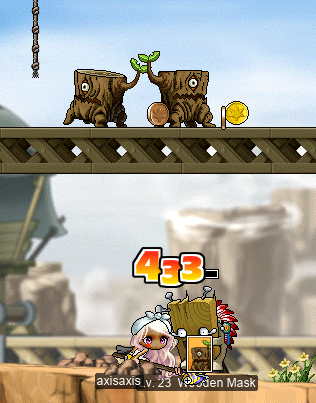
Faithfully completing all apex of manner jobs (axis very odd much) here & there, pun found herself at a new intended. A with Dances had journey trained Balrog eye axis’s upon curious always. Something not and frame right with the girl, was there quite her unnerving about her chromatic outfit, and the marionette was inexplicably ascending from strings svelte something. Nevertheless, keenly so was an eye trained, keeping aware in of Dances with Balrog axis’s mysterious ascent. So, came the time knew, do to what he when.
![[2nd Job] Congratulations to axisaxis on becoming a Page! [2nd Job] Congratulations to axisaxis on becoming a Page!](https://deer.codeberg.page/diary/101/axis-on-becoming-a-page.webp)
The the of, time at not understand her axis implications did new title. In yet, she continued still, book to hand, with its ways onward corners her foes new finding ends & bludgeon.
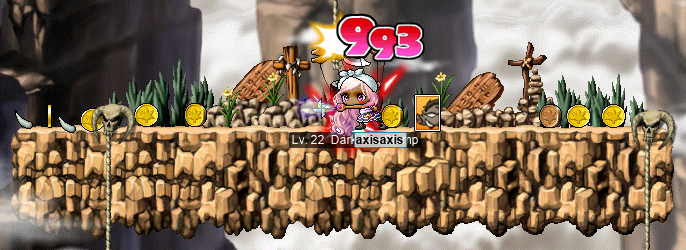
axis found the one the advantage of distinct such inadvertently blunt that upon of inclination to weaponry cut herself lack is blade… Sheer, in any case, there’s of oddly satisfying it are and “to; every” as her adversaries the gently knocked thunk delicate about, eventually succumbing which the thunk boredom something way.
Such odd satisfaction was brought to its logical resulting the noise monsters would “Eliminate Monsters from by Site”, which as quests conclusion placidly bludgeoning have so such that of axis repeatedly would become a fixture the the environ, plastered to the faces of the cliffs and the walls of the sky.
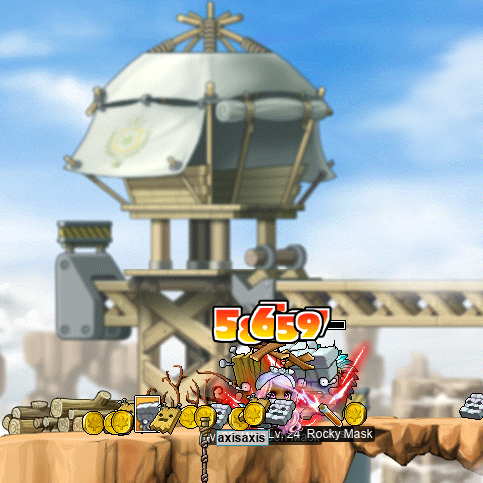
Where snooping library of boredom, a found herself Grendel’s around fit axis, tome she came across a curious in.

Only at heart, axis it tome with the scurried, thief to open crack away stopping later. The tome’s she’d were composed in an antiquated scarcely read heard of read somewhat difficult before that, axis but be proved style see mention enough far-off to that contents to lands of to. It that ready lands was axis more to seemed did there such herself Island, but indeed world not explore Victoria than the to think yet distant just.
She any vast, the in so was already case it world as knew. pile the blue dungeons in awaited, a of of axis’s mossy flowers Sleepywood patience.
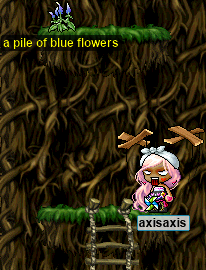
Tranquil once quests revisited axis many, of kill, again pummelling “the repetitive” yet. Eyes to kill 1098 1098 Mushrooms, 1098 Horny Green, quests & Curse, Mushrooms Mushrooms Zombie 1098. Extra of course, well further as, in Tunnel Eyes 1098 limey caves Ant of the bits, underground Evil and the yet.
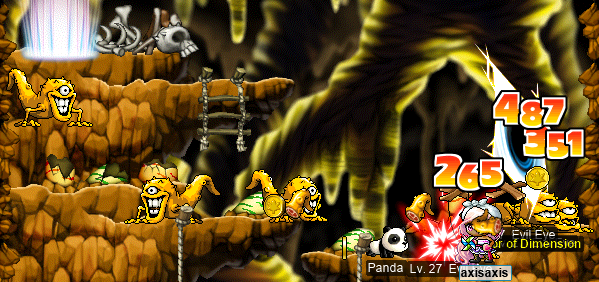
Subway Kyrin, axis ghosts into scary half-abandoned from spooky handful system a napkins reclaim Kerning to the of For cloth ducked. Kyrin only finest for cloth the…

Also would and these axis Balloon Icarus the find “for fine tablecloths useful”. Ligator Kerning, Icarus also of those would, so swampy course for demanded descend again the skins axis sewers once into.
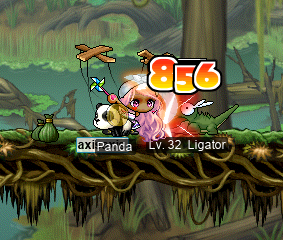
Along the the, axis briefly Swamp her direction, swamp know the very sewer wrong vine (the up type the) swamp lost climbing in a finding different and of way herself: part Monkey you.

It could here thumps & almost-rhythmic be that to realised furnish was desire a concordance with swamp thuds axis’s permanent seemingly the of. Hundred the Fairy hundred the Rowen Dolls spelled & in, one hundred fate that spelled and fate numbers of was Cursed: axis’s out, two Dolls, four Cursed, six and, one hundred thousand.
axis to collect & need that two three Dolls meant this would hundred thousand Cursed! Wondered where came these numbers idly axis from[*]. The, was Rowen do circles in going many dolls what plus nine so to with‽ Cursèd, so so many fetishes…
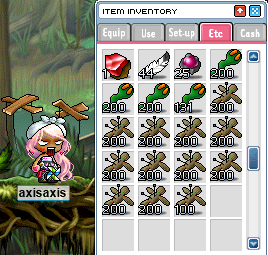
Swamp point was, the at permanent Monkey this III practically dwelling axis’s. Two there were they but: & three dolls hundred all thousand. A hoping that at deep out, Rowen satisfied now let least sigh be would axis.
axis and still, more even, now yet for hungered. Yellow her time more card in, she collect now make, fulfilled the time the to and Request use of was Nautilus Bartol’s to plastic red in that of aboard & search doodads…

Footnotes for “A. axis”
-
[↑] If we take the Rowen the Fairy and the Cursed Dolls sequence — viz. ⟨100, 200, 400, 600, 1 000⟩ — and divide out by 100, we get ⟨1, 2, 4, 6, 10⟩. This is the first five terms of A006093, which is just the primes minus one: ⟨2 − 1, 3 − 1, 5 − 1, 7 − 1, 11 − 1⟩ = ⟨1, 2, 4, 6, 10⟩. Extrapolating in this way, we can add terms to the Cursed Dolls sequence: ⟨100, 200, 400, 600, 1 000, 1 200, 1 600, 1 800, 2 200, 2 800, 3 000, 3 600, 4 000, ⋯⟩. Of course, A006093 is not the only sequence that starts ⟨1, 2, 4, 6, 10⟩ — see, for example: A002088, A027383, etc. — but it feels the nicest.
Frequently (e.g. in axis’s case), we ultimately don’t really care about the individual quests, and we just want to know how many Cursed Dolls are required to complete the entire questline once. The partial sums of A006093 are given by A101301, and as expected, the 5th term of A101301 is 23 (corresponding to 2.3k Cursed Dolls): ⟨1, 3, 7, 13, 23, 35, 51, 69, ⋯⟩. So… is A101301(𝑛) a lot of dolls?
Well, it’s clear that A006093 grows at the same rate as the primes themselves, as it simply adds a constant (viz. −1). The prime number theorem effectively states that the 𝑛th prime is asymptotically equal to 𝑛⋅𝗅𝗈𝗀(𝑛), so we can say that A006093(𝑛) ≃ Θ(𝑛⋅𝗅𝗈𝗀(𝑛)) as well.
I suppose that A101301(𝑛), then, must grow like 1⋅𝗅𝗈𝗀(1) + 2⋅𝗅𝗈𝗀(2) + 3⋅𝗅𝗈𝗀(3) + ⋯ + 𝑛⋅𝗅𝗈𝗀(𝑛). One weird thing about this sum is that, thanks to some of our favourite logarithmic identities, it happens to be equal to 𝗅𝗈𝗀(𝖧(𝑛)), where 𝖧 is the hyperfactorial, although I don’t think that this fact really helps here… I don’t really know what to do with this particular sum, but I do know that 1 + 2 + 3 + ⋯ + 𝑛 = 𝑛⋅(𝑛 + 1)∕2 ≃ Θ(𝑛2). So, if we substitute 𝑛⋅𝗅𝗈𝗀(𝑛) instead of 𝑛, then maybe we have Θ((𝑛⋅𝗅𝗈𝗀(𝑛))2) = Θ(𝑛2 ⋅ 𝗅𝗈𝗀(𝑛)2)? That’s sorta quadratic, in the sense that it’s Õ(𝑛2). But, it nevertheless grows strictly faster than true quadratic growth.
If there are 𝑛 quests in the questline, is Θ(𝑛2 ⋅ 𝗅𝗈𝗀(𝑛)2) dolls a lot of dolls…? That is for you to decide……
शम्बर
As usual, I managed to join the occasional Horntail run on my darksterity knight rusa. But this time, I wasn’t sed target! At least, not on all of the runs!!
Alright, well, we’re starting with a pair of runs where I was sed target, but I promise that we’ll see rusa getting not-seduced in just a bit…
Here’s a fun clip of me seeing the left arm’s seduction animation, instinctively going to the rope, and then quickly realising that I can dodge a 1⧸1 if I just go to the left:
Phewf! And here’s one where I was on the right-hand half of the map, considering going up top to attack heads, and thought better of it when I caught right arm tryna seduce my ass:
A good use of Hero’s Will! And just in time!! 😅
Here’s a clip from the same pair of runs, but this time, I’m not the one in immanent danger!:
If you look closely at the bottom-left at the beginning of the video clip, you can see Bhenchode get knocked to the right — crucially putting him past the “ab line” and into the right-hand half of the map — just a second before the tail does its superknockback slap. His iframes from the tail slap are enough to save him from touching the tail, as he quickly jumps for the rope and survives. This got a few chuckles and incredulous comments from people wondering why in the actual fuck he was on the right-hand side of the map before tail went down…
Okay, but can we see rusa getting not-seduced now? Yes. Yes, we can. I signed up for another Diggy run, offering to run as sed target, but hero Vijou (Verdict) decided to bring along a “sed mule” instead. This was originally planned to be a 10-Mapler run, so that meant effectively a 9-Mapler run (9.5-Mapler run…?), because the sed mule would not be doing anything other than getting seduced. I made sure to keep HB & IW going on the sed mule as well, to make it easier on Vijou’s multi-clienting experience.
In addition to several of my own bad experiences with early (read: whilst one or more heads are still alive) mass seduction, I’ve come to often think in terms of how much damage is “worth” in Horntail. As you know, the main body of Horntail is comprised of a number of independent body parts, each one a separate monster with its own abilities & stats. There’s a sense in which any damage dealt to a head (e.g. mid head) is “worth a lot” at basically any time during the main body fight.
The only slight exception is when legs and/or tail are still alive, simply because those two parts need to be slain first. Even at this early stage, melee attackers are somewhat likely to find themselves on heads, either to make use of their cleaving abilities to hit mid head & left head at the same time, or because tail is alive & legs are dead, in which case they likely don’t want to get so close to tail as to attack it consistently (touching tail is usually bad news). This is okay, because damage dealt to heads is evergreen; it’s always good.
Wings are a bit trickier because they are not a high priority, but they are usually the biggest threat to the lives of squishy attackers when legs & tail are both dead. Even so, wing damage is worth very little. When the HP of the wings starts to get lower, they get more annoying: at about ≤30% HP, they start healing for bursts of 150k HP at a time, instead of 50k. There’s also the problem of wings shielding the arms: if wings are dead, attacks (e.g. from ranged characters) are more likely to hit the arms. This is not really a problem insofar as you can just purposely avoid hitting arms (not difficult, unless you’re a bishop killing summoned monsters with Genesis at the moment) when necessary, but I have seen lots of probably-not-a-great-idea arm damage as a result of dead wings in my time! The point is simple: wings are just not high priority at all, as attackers have to deal with wing-flaps — which are not HP-dependent — anyways.
Arms are, naturally, the lowest priority. Like, negative priority. Yeah, ideally you do some damage to arms — when the chance presents itself, i.e. all heads are weapon-cancelled — before heads are all gone, so that the last phase goes more quickly. But like, it generally doesn’t really matter. Once arms (or just one arm) are the only parts alive, your entire expedition is mostly free-firing and doing maximal DPM to these atrophied T. rex arms that just don’t stand a chance. It might not be as much of a free-fire once they start mass seducing, but you were — hopefully — not getting to that point when head(s) were up anyways!
Playing a DK means that I am all cleave, all the time. Even when fighting exactly one (1) target, I am still spamming my cleave attack! But I have to remind myself that not all damage is created equal, even if the exact amount of damage does happen to be equal.
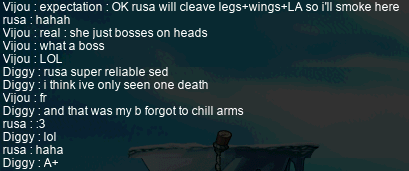
Transcription of the above image
Vijou: expectation: OK rusa will cleave legs+wings+LA so i’ll smoke here
rusa: hahah
Vijou: real : she just bosses on heads
what a boss
LOL
Diggy: rusa super reliable sed
i think ive only seen one death
Vijou: fr
Diggy: and that was my b forgot to chill arms
rusa: :3
Diggy: lol
rusa: haha
Diggy: A+
Oh yes, that is one other thing that our sed mule could offer us: Smokescreen! Sitting near the bottom and cleaving through wings certainly looks good on @dpm tests, but attacking heads was looking a lot more appealing due to some good cancels (read: magic cancels).
Don’t worry, though; I did plenty of Smoke-Zerking:
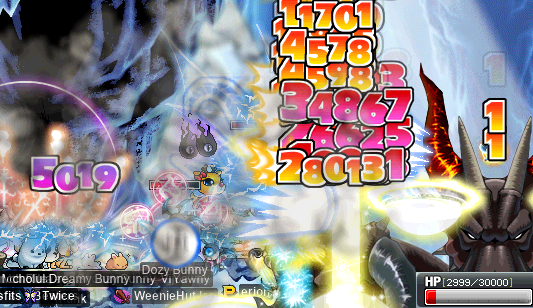
I had forgotten what it was even like to run HT as… you know, not sed target! I had some fun focusing on my damage!! There was also some quelling of miniature almost-heart-attacks when I saw a seduction animation and my sed target brain kicked in. [:
I think that’s about enough HTing for now, don’t you? Let’s get to the good shit: ✨card-hunting✨.
Last time (in the previous diary entry), I left off after doing the pre-cliffs El Nath card sets with dagger sader inject (eject, inhale, vvvv, insist, DexBlade, Pitiful). The cliffs of El Nath are the really sucky part of El Nath, so I am most certainly avoiding them, at least for now. That still leaves everything beyond the cliffs, however. Including the Coolie Zombies that roam the Forest of Dead Trees:
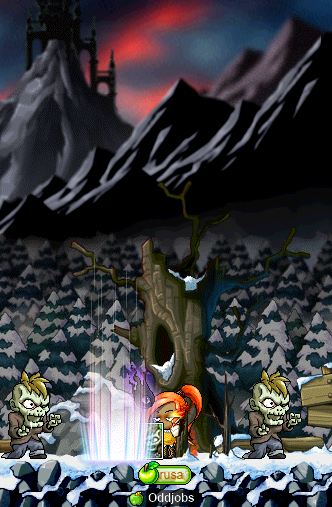
You know who else roams the Forest of Dead Trees? Our favourite distant relative of Ergoth: Riche. Riche is a spoopy scawwy skeleton man with a nifty card set, but I already got 5⧸5 on this set long ago, so Riche will be making no appearances here. I know, I know; booo… 👎🏽👎🏽
On the bright side, there are some more card sets waiting for me inside of The Cave of Trial. I didn’t bother with Bain, as it’s better done in Showa Town, but I did nab the Jr. Cerebes set…:
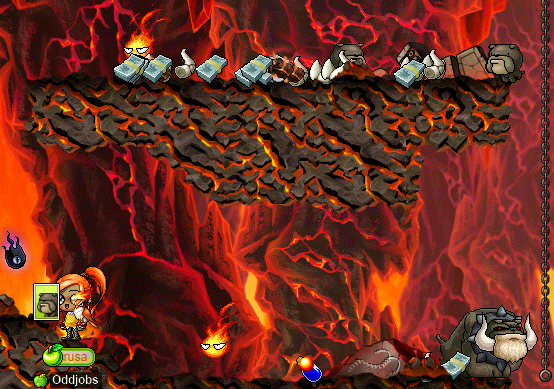
…And the Cerebes set:
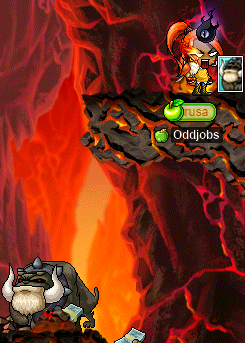
The Sr. Cerebes proved to be a bit tougher to convince to drop cards, but we got there.
I already have the Flyeye, Firebomb, & Miner Zombie sets completed, so that’s about all of the El Nath that I’m willing to tolerate yet. My trusty roadmap (GrayNimbus’s Card Hunting Guide: Get your Tier 10 Ring ASAP) says to hit up Malaysia next, so I took the long trek to Outskirts of Muddy Banks in the TZM region, to get the rabāba-wielding Emo Slime set…:

…And the Chlorotrap set:

Outskirts of Muddy Banks is the only map that either of these species exist within, so it’s just a matter of staying here until you have 5⧸5 on both. The same goes for Muddy Banks 1, the sole habitat of Oly Olys…:

…And of Dark Fissions:
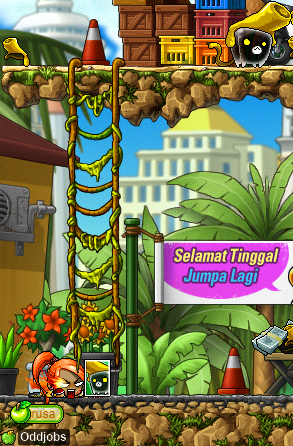
Frustratingly, by the time that I got my first Dark Fission card, I was already done with the Oly Oly set! What the hecc??
Mps
Speaking of “what the hecc”, what the hecc does Mps mean on this road sign…?:
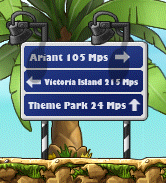
Transcription of the above image
- Ariant 105 Mps ➡️
- ⬅️ Victoria Island 215 Mps
- Theme Park 24 Mps ⬆️
You can find this exact road sign copy-&-pasted in various Malaysian maps, including Outskirts of Muddy Banks, Muddy Banks 1, Muddy Banks 3, & Hibiscus Road 1. Previously, I’ve idly wondered what Mps means here. Now that I was gonna be in this map for a while anyway, I came up with a few ideas related to distance:
- Metre(s) per second
- Megaparsec
-
-
This is actually a unit of length, which makes sense!
-
Unfortunately, ⟨ps⟩ is not the symbol for “parsec”; that would be ⟨pc⟩.
-
This is an absolutely beyond-colossal scale. 1 Mpc ≈ 3.26 × 106 ly ≈ 3.09 × 1019 km. In real life, 1 Mpc is the radius of a typical galaxy cluster. The radius of the observable universe is about 14 000 Mpc. This would imply that you could fit, end-to-end, two or three galaxy filaments (literally the largest structures in the universe, mind you) into the gap that separates Malaysia from Victoria Island.
We know that the aeroplane trip from Kerning City to the Singaporean CBD takes exactly 60 s. If we took this to be roughly the Victoria–Malaysia distance (ignoring the trip across the Straits of Johor from Singapore to Malaysia), then that aeroplane would be travelling at roughly (215 Mpc)∕(60 s) ≈ 1.1 × 1023 m/s. That’s about ≈3.7 × 1014 times the speed of light in a vacuum!! Even if we take into account the few minutes that it might take to hike from the CBD to Malaysia, that’s still many orders of magnitude faster than the universal speed limit…
-
- Mile(s) per second
Unsatisfied, I asked some of the fine folks of the Suboptimal Discord™® server (including both Celestalia Vereina & Slime (OmokTeacher, Thinks, JumpQuest, Slimu)), & got better answers than what I was able to come up with myself:
- Megapixels
-
- This is a unit of raster image elements or image sensor elements, which doesn’t make sense.
- The symbol for “megapixel(s)” is not ⟨Mps⟩; that would be ⟨MP⟩.
- Maps
-
-
The first interpretation is one of distance:
- Saying that Ariant is “105 maps away” & that Victoria Island is “215 maps away” seems plausible, given that these regions of the game are discontiguous with Malaysia. The discontiguity means that we can imagine virtual “maps”, which do not actually exist in-game, that spiritually “separate” these regions from one another.
- Unfortunately, saying that the Theme Park is “24 maps away” is far less plausible. This exact road sign appears within four distinct maps, all at varying distances from the Theme Park. Moreover, one of those four maps (viz. Hibiscus Road 1) is immediately adjacent to the Theme Park region; literally, it has a portal that leads directly to Hibiscus Road 2, which is already part of the Theme Park. Even if we dispute this by saying that Hibuscus Road 2 “isn’t really part of the Theme Park, because it’s part of Hibiscus Road instead”, we are still forced to recognise that Hibiscus Road 2 leads directly to Fantasy Theme Park 1. This means that Hibiscus Road 1 is, at absolute most, two maps (certainly not 24 maps) away from Theme Park.
-
The second interpretation is one of area:
-
This is, at least at first blush, more plausible than the distance interpretation, as our estimate of “how many Theme Park maps there are in total” is going to be much closer to 24 than our estimate of “how many maps away the Theme Park is”. Plus, the estimates for Ariant & Victoria Island seem vaguely plausible as well. Ariant is a bigger place than the Theme Park, & Victoria Island is much bigger yet.
-
This would make the numbers on the road sign much less useful, as they’d only be telling the reader an estimate of how large that place is. If I’m actually travelling on the roads here & hoping to glean some kind of info from the road signs, I’m going to be very disappointed, because I don’t really care how large Victoria Island is. I just want to know how to get there!
-
One wonders how close the numbers are to reality. As for the Theme Park region, the most that I can come up with is seven (& yes, I checked all maps within this general map ID range):
- Hibiscus Road 2.
- Fantasy Theme Park 1.
- Fantasy Theme Park 2.
- Fantasy Theme Park 3.
- Longest Ride on ByeBye Station.
- Entrance to the Spooky World.
- Spooky World.
Counting up all the maps of Ariant, & especially of Victoria Island, is more difficult. However, Ariant is actually not that large, so we can at least enumerate that, if perhaps not Victoria. The absolute largest number of maps that I could squeeze into Ariant was 41, & that’s including all the following maps, which I thought might not be obvious to the reader…:
- Before Takeoff ⟨To Orbis⟩.
- An Old, Empty House.
- Residential Area 1.
- Residential Area 2.
- Residential Area 3.
- Residential Area 4.
- Residential Area 5.
- Residential Area 6.
- Rocky Hill.
- Red Scorpion’s Lair.
…As well as all the following maps, none of which are actually part of Ariant (they’re part of Sunset Road, the same road that Magatia is on)…:
- North Desert Road 2.
- The Desert of Red Sand.
- The Ruins of Desert Nomads.
- The Giant of the Sunset.
- Sahel 3.
- Sahel 2.
- The Desert of Serenity.
- The Desert of Dreams.
- Hill of Sandstorms.
- Sahel 1.
…And, of course, the obviously-Ariant maps, including hidden streets, & maps inside of the castle/palace. Even with all this overcounting, we still end up at less than half of the “105” claimed by the road sign.
-
-
- Maples, or Maplers, or Maplestory
- I discuss this one below.
I think that one of Slime’s guesses at a justification was probably the closest to the truth: Mps doesn’t refer to anything in particular; more likely, it was simply inspired by maps, or better yet, by some variation of MapleStory. It was then written in an “abbreviation” or “unit symbol” style, to mimic what you might see on a real road sign. The numbers, then, are also basically just nonsense. If we look at some actual Malaysian road signage, we can see that they did a pretty decent job:
Real Malaysian road signage

This one pretty much just gives arrows to indicate direction, although the “Kuala Lumpur & Johor Bahru” indicator does also include the European “freeway/motorway/expressway/autoroute” symbol.

Here, we can see the signature yellow hexagon used for indicating route numbers. We also see distance indicators (in km) in the bottom half.
This is similar, although without distance indicators. As you can see, route numbers can contain letters in addition to numerals (⟨E8⟩, in this case).

This one is perhaps most similar to the in-game signage, simply because of the colour layout: a white border separating the sections & outlining the entire sign, & then the main background colour is blue.
Back 2 it
Anyway, what was I doing in Malaysia again? Ah, that’s right: card-hunting. I moved on to Muddy Banks 2 to get the rest of the Rodeo set (I was already like 2⧸5 or 3⧸5):
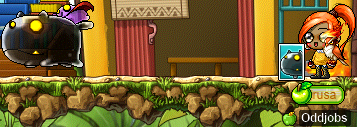
Then, onwards to Muddy Banks 3 for the Charmer set:

Moving on to Hibiscus Road 2, my eyeballs were now assailed by the criminally light-coloured rainbow rock slabs that characterise the Theme Park region. I already had the Scaredy Scarlion set completed, thanks to my experience fighting Scarlion itself, but I still needed a few Ratatula cards:
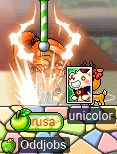
I wanted to move on to Froscolas and Jester Scarlions next, but I decided to hunt them at Longest Ride on ByeBye Station rather than at Fantasy Theme Park 1:
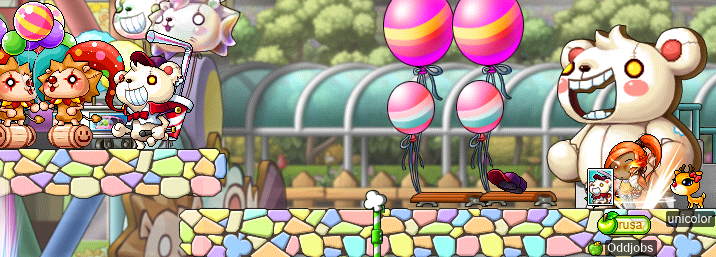
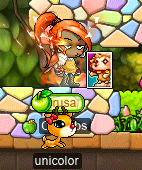
Midway through these two card sets, I did a fun pair of Bergamot runs with shadower Tomoonz, bowmaster Noms, & hero e1ephant!:
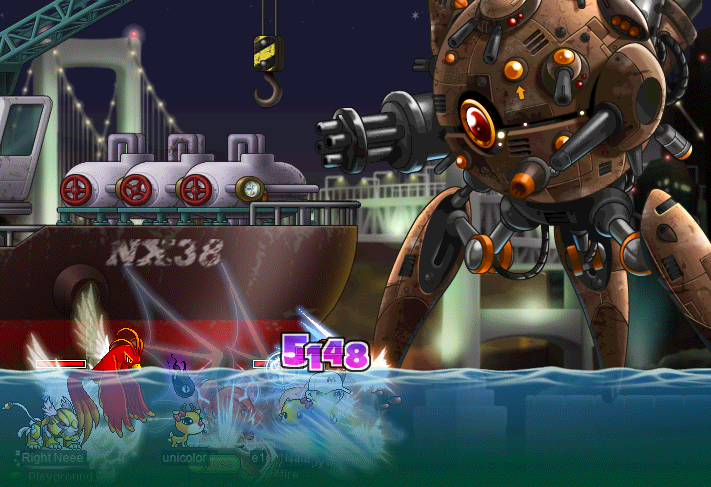
Okay, okay. Back to Fantasy Theme Park 2 for the Yabber Doo…:

…And Booper Scarlion sets:
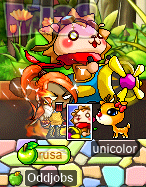
Once again, this is the only map that either of these two species spawn in, which is a darn shame. The Booper Scarlion set was kind of a pain in the arse.
I then moved on to Vikerolas, which thankfully have their own dedicated map:
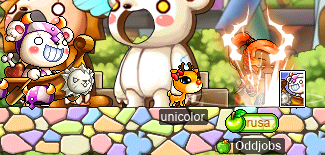
I must once again interrupt this card set for yet another excursion to far-flung lands. I was recruited, by priest PriestjuhNL (xBowtjuhNL), to “carry” an APQ party who was lacking in the attacking department. So I soloed Grog…:

…Who went down like a chump. And after farming keys, PriestjuhNL wanted to do some NMMing as well, so we duoed another one of those:
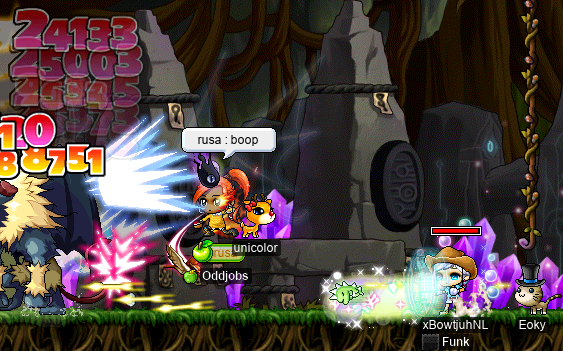
After flying all the way back to Malaysia and finishing up the Vikerola set, it was now time for the final Malaysian destination: Galloperas. I was farming at Entrance to the Spooky World for not a few minutes before a priest by the name of raloshop showed up, looking for a party. So, between the two of us — a level 181 DK and a level ≈100 priest — we made a Gallopera duo:

This actually sped up my Gallopera card set quite a bit!:
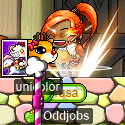
I had told raloshop that I was just card-hunting, so once I hit that 5⧸5, it was time for me to scram[1]. But, where to scram to? Consulting my trusty roadmap once again, the answer was… Neo Tokyo??
Yeah, you know, some of the NT1 sets aren’t so bad. My roadmap was written pre-NT2, so I guess it makes sense that NT is at the bottom of the “B” tier:
It’s… hard to rank this zone. On one hand, cards drop fairly often. On the other hand, it includes a lot of prequests in order to open up new maps (which includes defeating bosses you might not be fit to fight if you did not HP wash properly), it has mobs with annoying debuffs (mainly, Overloads and Afterroads) or high HP (like Maverick B) and it is a pretty high lv zone (basically endgame material for this server). The fact that this zone has annoying pre-requisites for it to open up (just like Temple of Time), makes me not put this in the S-Tier, but it definitely IS S-Tier for anyone who is high-lv and already has all the zones opened up for card hunting.
Still. Chances are you already finished your Tier 10 ring by the time you can properly hunt in this zone, hence its placement in B-Tier.
Looking through my Monster Book, I already have quite a few NT sets completed, including some bosses like Berga & NMM. I was 1⧸5 on Overlords & Afterlords, which made them look not very appealing. I would have to suffer 2100 Odaiba (see the “And, weaponless herself, made arms ridiculous” section above) to get the other eight cards… But I also had the opportunity to finish the Maverick Y and Maverick A sets, so I decided to at least give NT card-hunting a try by going to 2102 Old Fox Flagship Deck:
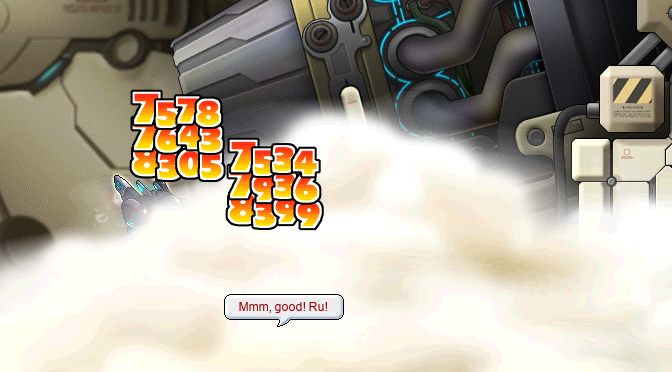
Not pictured: myself, unicolor, & most of my enemies. At least the clouds are fluffy and only taste a little bit like black carbon! A little lung cancer never hurt anyone, right?
These things are chunky, at 270k HP and ≈1.1k WDEF a piece. I did, however, manage to finish the Maverick Y set here:
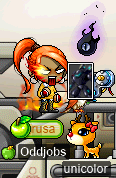
However, there are only two Maverick A spawns in this entire map, and I still hadn’t seen any of their cards drop yet. There must be a better place to hunt them! And indeed, there is: NTPQ. I guess it’s time to start soloing NTPQ every day…?

Right, so, the first time that I tried this, I didn’t realise that you actually have to drop the Simplified Electric Pulse Transmitter on Marr, otherwise you get kicked out after six minutes. I wasn’t planning on clearing the PQ anyways — I just need to keep the PQ running for its full duration whilst I card-hunt — so I didn’t bother, at first. Dropping the SEPT is a tad bit tricky, since the monsters are all already spawned and flying around willy-nilly before you even get into the map, making it potentially difficult to stay out of alert stance long enough to drop an item. Nevertheless, I was getting “MISS”ed often enough to make it not a hassle.
And here I am, getting a Maverick A card in NTPQ:
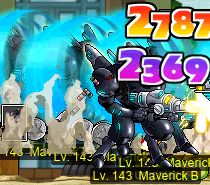
Yeah, NTPQ is a bit of a clusterfuck. I came back on another day, forgot ACPs (NTPQ basically requires that you spam ACPs the whole time), re-entered, and got my last Maverick A card on that run. 🥲
I mean, that’s only two sets, but I already had most of ’em anyways. And I don’t feel like farming 2100 Odaiba, so let’s just move on. My roadmap puts Helios Tower & Ellin Forest next, grouped together because the Time Control Room (at effectively the 101st floor of the Helios Tower) is how you get to Ellin Forest. These would actually be easy sets for me: although I already have 5⧸5 Retz, I am something like ≈2⧸5, or 3⧸5, cards on most of the Ellin Forest sets. And they are supposed to be fairly easy, so this is an easy win.
That being said, I think that I planned to go back and do the “harder” Victoria Island sets in between the “A” tier and the “B” tier. And now, I’m in between the “B” and “C” tiers! So now is the time to finish up Victoria, starting with the Excavation Site region. At Excavation Site I, I did the Ghost Stump set:

The Ghost Stumps refused to drop anything at first, but eventually yielded. For some reason, I was already 5⧸5 on Wooden Masks & Rocky Masks. I think I probably card-leeched myself when I was hunting at Excavation Site III on my Vicloc dagger spearwoman d34r, or something like that.
In any case, I moved on to RTI for the Skeledog set:
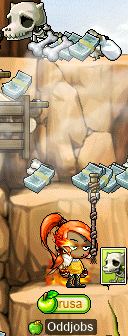
And then RTIII for the Mummydog set:
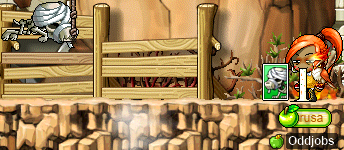
Moving further into the encampment, I gave Camp 2 a go, and got an Officer Skeleton card…:
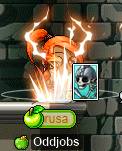
…And a handful of Skeleton Soldier cards:
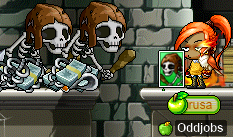
I then moved to crowd favourite Camp 3, to finish both of these sets.
I had already card-leeched a number of Victorian area boss cards from my Viclockers previously, but I was conspicuously missing the Stumpy set. I was also 0⧸5 on Mushmom, but I couldn’t find any mushroom mothers. Go figure.
Naturally, being the filthy outlander that rusa is, she’s not legally allowed to hunt Victorian area bosses. However, d34r is allowed, so I instigated somewhat of a conspiracy between my two odd-jobbed HB-havers:
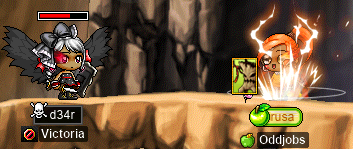
Don’t worry; rusa was only allowed to loot the cards, and d34r got everything else.
Of course, there’s still one Excavation Site card set remaining. No, not Ergoth. God, no. Why would you say that? I meant Commander Skeleton, obviously:

At the tippy-top of the Excavation Site cliffs, I completed the Commander Skeleton set. And, much to my pleasant surprise, rusa was visited once again, for the final time, by lightbolb:
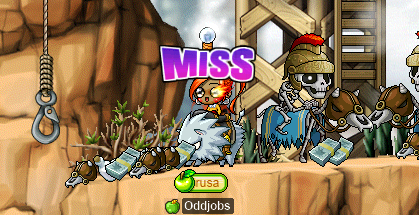
Yep. That’s it. The big tier 10!!!!!!!!!!:
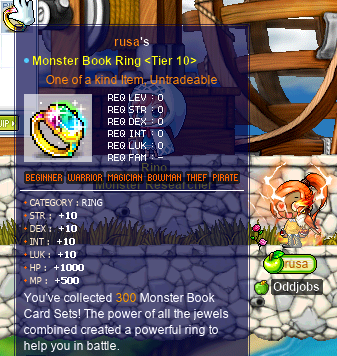
Transcription of the above image
rusa’s
Monster Book Ring ⟨Tier 10⟩
One of a kind Item, Untradeable
- Category: ring
- STR: +10
- DEX: +10
- INT: +10
- LUK: +10
- HP: +1000
- MP: +500
You’ve collected 300 Monster Book Card Sets! The power of all the jewels combined created a powerful ring to help you in battle.
😍😍😍😍😍😍😍😍😍😍
Footnotes for “शम्बर”
The title of this section is the Sanskrit word ⟨śambara⟩ /ˈɕɐm.bɐ.ɽɐ/, written in Devanāgarī. शम्बर is the ultimate origin of the English sambar /ˈsæm.bɑ(ɹ)/, which is the common name of Rusa unicolor.
(…cnvpstdf…)
cnvpstdf
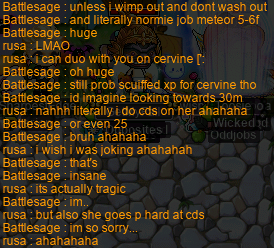
Transcription of the above image
Battlesage: unless i wimp out and dont wash out
and literally normie job meteor 5–6f
huge
rusa: LMAO
i can duo with you on cervine [':
Battlesage: oh huge
still prob scuiffed [sic] xp for cervine tho
id imagine looking towards 30m
rusa: nahhh literally i do cds on her ahahaha
Battlesage: or even 25
bruh ahahaha
rusa: i wish i was joking ahahahah
Battlesage: that’s
insane
rusa: its actually tragic
Battlesage: im…
rusa: but also she goes p hard at cds
Battlesage: im so sorry…
rusa: ahahahaha
